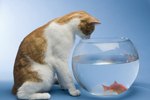
Ammonia and nitrogen are generally measured together in a tank. Both are toxic and detrimental to the inhabitants in a saltwater tank. If fish or plants become lethargic or start to die, checking the ammonia level should be your main priority, especially in a newly established tank. Controlling the ammonia in the tank helps ensure the inhabitants thrive.
Water Changes
Water evaporates and becomes dirty, making water changes necessary. This creates issues for saltwater aquariums susceptible to high ammonia levels due to the high level of chlorine, an unstable gas, which releases ammonia. Before adding tap water to your aquarium, treat it with a conditioner that treats chlorine. This prevents the buildup before it starts. Test the tap water’s ammonia level with an over-the-counter kit after treating it and before adding it to your aquarium.
Control Waste
Fish food, waste and organic plants release ammonia and nitrate as they begin to decay. Therefore, avoid overfeeding your fish and remove any leftover food and dead plants, fish and leaves immediately to help control ammonia levels. Test your water often for ammonia and nitrates. The nitrates should remain lower than 40 ppm and the ammonia at zero for saltwater tanks.
Pick the Right Filter
Use a commercial filter in your tank that promotes bacteria growth to inhibit ammonia production. The manufacturer's specifications should indicate that the filter helps maintain live bacteria. Also, utilize the experts at your local fish store and ask which filter helps lower the ammonia levels specifically for saltwater aquariums. Make sure the filter you choose is large enough to support your tank size as well. Check and clean your filter immediately if ammonia starts to accumulate in your tank.
Temperature and pH
Keep your tank water at a constant temperature and the ph level slightly high. Eliminate ammonia by slowly dropping the temperature in the tank if your fish can tolerate it. For instance, a tank at 68 degrees Fahrenheit has less ammonia than a tank at 80 degrees Fahrenheit. However, when the temperature drops below 60 degrees, the good bacteria begin to decrease so avoid dropping it too low.
Use pH strips available at your local fish supply store and test the water weekly. Keep the pH level between 8 and 8.5 to maintain the ammonia level. Adding carbonate to salt water increases the pH level and helps eliminate ammonia.
References
Resources
Photo Credits
-
Ablestock.com/AbleStock.com/Getty Images
Writer Bio
Amanda Maddox began writing professionally in 2007. Her work appears on various websites focusing on topics about medical billing, coding, real estate, insurance, accounting and business. Maddox has her insurance and real estate licenses and holds an Associate of Applied Science in accounting and business administration from Wallace State Community College.




